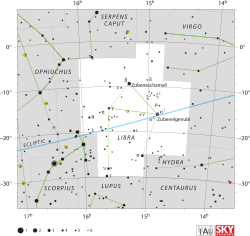Kappa Librae
| Kappa Librae (κ) | |
 | |
| Observationsdata Epok: J2000.0 | |
|---|---|
| Stjärnbild | Vågen |
| Rektascension | 15t 41m 56,79858s[1] |
| Deklination | -19° 40′ 43,7745″[1] |
| Skenbar magnitud () | +4,72[2] |
| Stjärntyp | |
| Spektraltyp | K5 III[3] |
| U–B | +1,94[2] |
| B–V | +1,58[2] |
| Variabeltyp | Misstänkt |
| Astrometri | |
| Radialhastighet () | -4,5 ± 1,5[4] km/s |
| Egenrörelse (µ) | RA: -32,06[1] mas/år Dek.: -103,15[1] mas/år |
| Parallax () | 10,57 ± 1,40[1] |
| Avstånd | 310 lå (90 pc) |
| Detaljer | |
| Radie | 38[5] R☉ |
| Luminositet | 296[6] L☉ |
| Temperatur | 3 930[6] K |
| Andra beteckningar | |
| κ Lib , 43 Librae , BD -19° 4188, FK5 1413, HD 139997, HIP 76880, HR 5838, SAO 159442.[7] | |
Kappa Librae (κ Librae, förkortat Kappa Lib, κ Lib) som är stjärnans Bayerbeteckning, är en jättestjärna belägen i den östra delen av stjärnbilden Vågen. Den har en skenbar magnitud på 4,72[2] och är svagt synlig för blotta ögat. Baserat på parallaxmätning inom Hipparcosuppdraget på ca 10,6 mas,[1] beräknas den befinna sig på ett avstånd av ca 310 ljusår (90 parsek) från solen.
Egenskaper
[redigera | redigera wikitext]Kappa Librae är en orange till röd jättestjärna av spektralklass K5 III.[3] Den har en uppskattad radie som är 38[5] gånger större än solens och utsänder från dess fotosfär 296 gånger mera energi än solen vid en effektiv temperatur på ca 3 900 K[6]. Stjärnan visar accelerationskomponenter i dess rörelse genom rymden, som med stor sannolikhet tyder på att den är en astrometrisk dubbelstjärna.[8] Det är också en misstänkt variabel stjärna med en variation i magnitud mellan 4,70 och 4,75.[9]
Källor
[redigera | redigera wikitext]- Den här artikeln är helt eller delvis baserad på material från engelskspråkiga Wikipedia, tidigare version.
Referenser
[redigera | redigera wikitext]- ^ [a b c d e f] van Leeuwen, F. (2007), "Validation of the new Hipparcos reduction", Astronomy and Astrophysics, 474 (2): 653–664, Bibcode:2007A&A...474..653V, arXiv:0708.1752 Freely accessible, doi:10.1051/0004-6361:20078357
- ^ [a b c d] Johnson, H. L.; et al. (1966), "UBVRIJKL photometry of the bright stars", Communications of the Lunar and Planetary Laboratory, 4 (99), Bibcode:1966CoLPL...4...99J.
- ^ [a b] Houk, Nancy; Smith-Moore, M. (1978), Michigan catalogue of two-dimensional spectral types for the HD stars, 4, Ann Arbor: Dept. of Astronomy, University of Michigan, Bibcode:1988MSS...C04....0H.
- ^ de Bruijne, J. H. J.; Eilers, A.-C. (October 2012), "Radial velocities for the HIPPARCOS-Gaia Hundred-Thousand-Proper-Motion project", Astronomy & Astrophysics, 546: 14, Bibcode:2012A&A...546A..61D, arXiv:1208.3048 Freely accessible, doi:10.1051/0004-6361/201219219, A61.
- ^ [a b] Lang, Kenneth R. (2006), Astrophysical formulae, Astronomy and astrophysics library, 1 (3rd ed.), Birkhäuser, ISBN 3-540-29692-1. The radius (R*) is given by::
- ^ [a b c] McDonald, I.; et al. (2012), "Fundamental Parameters and Infrared Excesses of Hipparcos Stars", Monthly Notices of the Royal Astronomical Society, 427 (1): 343–57, Bibcode:2012MNRAS.427..343M, arXiv:1208.2037 Freely accessible, doi:10.1111/j.1365-2966.2012.21873.x.
- ^ "kap Lib -- Variable Star", SIMBAD Astronomical Database, Centre de Données astronomiques de Strasbourg, hämtad 2017-01-30.
- ^ Makarov, V. V.; Kaplan, G. H. (May 2005), "Statistical Constraints for Astrometric Binaries with Nonlinear Motion", The Astronomical Journal, 129 (5): 2420−2427, Bibcode:2005AJ....129.2420M, doi:10.1086/429590
- ^ Samus, N. N.; Durlevich, O. V.; et al. (2004), Combined General Catalogue of Variable Stars (GCVS4.2), Bibcode:2004yCat.2250....0S.





